Small Island Developing States: vulnerability note
Published 17 January 2025
SIDS have to manage and overcome vulnerability across dimensions: economic, climate and environmental, governance and capacity, social, and financial. This note explores these vulnerabilities before briefly discussing priorities for shifting from vulnerability to resilience and how SIDS’ partners can help. For more detail on the Caribbean, see FCDO blog The Caribbean: Navigating Vulnerabilities in Paradise. The note uses some evidence on Small States (as defined by the World Bank) given strong crossover with SIDS.
The UK and the international community have recognised that Small Island Developing States (SIDS) are a ‘special case for sustainable development’ due to their combination of vulnerabilities. These vulnerabilities proliferate from SIDS’ structural characteristics of low economies of scale, remoteness, and environmental risks, while affecting SIDS’ external financing opportunities. The climate crisis exacerbates SIDS’ economic and social vulnerabilities, including through food production, labour productivity, infrastructure, health, social inequities, culture, and social structure.
While there are many ways to measure vulnerability, most SIDS rank as highly vulnerable across different vulnerability indicators and are consistently more vulnerable than countries at a similar income level. SIDS are 35% more vulnerable than other developing countries (UNCTAD, 2021) while Upper Middle Income SIDS are 73% more vulnerable than countries at a similar income level (OECD, 2018). In the recently developed UN Multidimensional Vulnerability Index, 70% of SIDS score above the median, indicating significant structural vulnerability and a lack of structural resilience (UN, 2023 (PDF 3.8 MB)).
Box 1: Measuring vulnerability
Much work has been done to build consensus on vulnerability measures and how they are used in finance. Agreeing on a vulnerability measure across different types or ‘dimensions’ of vulnerability – a Multidimensional Vulnerability Index (MVI) – has been difficult, particularly in determining weights of different factors and managing ‘winners and losers’ of any possible financing change. The UN has developed a new MVI and in August 2024 the UN passed a Resolution to adopt it, though its use remains voluntary. The UN MVI builds on other MVIs including the Commonwealth Universal Vulnerability Index (PDF, 10.9 MB) and the UN Economic & Environmental Vulnerability Index (EVI) (UN, 2021 (PDF, 1.9 MB)). International Financial Institutions measure vulnerability but not all using an MVI. For example, World Bank International Development Association has a Small Economies Exception (WB, 2024 (PDF, 5.4 MB)), while the Asian Development Bank uses the UN EVI (ADB, 2024 (PDF, 516 KB)).
Economic vulnerability
SIDS’ smallness and remoteness increases transaction costs of business and trade. Long distances to potential trading partners push up costs of transport and logistics, with the South Pacific particularly far from major markets. Transport and logistics costs also swell with high dispersion within countries such as Solomon Islands. Geographic dispersion and remoteness negatively relate to public spending efficiency (WB, 2023 (PDF, 641 KB)).
Box 2: Case study – Logistics in Solomon Islands and Tonga
Solomon Islands has a population of 800,000 people, making it one of the larger Pacific Island Countries, but 5/6 of the population is outside the main island of Guadalcanal, on 90 inhabited islands across an area the size of Iran, but with 2% of the land. Some outer islands are only visited by boat a few times a year, meaning they are effectively subsistence economies. Government has insufficient capacity to deliver services there, undermining the sense of state, engagement in democratic process, and societal cohesion.
Tonga’s population is around 100,000 with 70,000 on the main island, Tongatapu. Small scale and extreme remoteness drive Tonga’s high trade costs.
Private sector development and growth are hampered by high transaction costs. Small populations limit labour markets, range of local businesses, and expertise, which further increases transaction costs of doing business including for government and development partners, while the scale of investment returns is limited.
Smallness and remoteness leads to narrow, highly concentrated economies with high trade dependence. Trade (total exports and imports) accounts for over 70% of SIDS’ GDP, compared to 50% for Least Developed Countries (LDCs) (UN, 2020). Small domestic markets limit countries’ ability to achieve economies of scale and diversify, and SIDS tend to concentrate economic activity where they have advantages, particularly tourism and primary commodities such as fisheries, which are subject to external shocks. Travel services account for almost half of SIDS’ exports and for 5 SIDS, seafood accounts for over 70% of goods exports (UNCTAD, 2021). SIDS are particularly dependent on remittances, which make up over 20% of GDP in Tonga, Samoa, Comoros, Haiti, Jamaica, and Vanuatu, while Tonga is the world’s most remittance-dependent country at 50% of GDP (WB, 2023; UNDESA, 2024 (PDF, 563 KB)). Pacific Island Countries also face some of the highest costs for remittance transfers, linked to their weak financial sector (Lowy, 2023). SIDS, most acutely in the Pacific, face a decline in correspondent banking due to the smallness of economies combined with perceived risks and low capacity for compliance, affecting SIDS’ external financing opportunities and further increasing transaction costs (UNCTAD, 2024 (PDF, 2.9 MB); PIF, 2023 (PDF, 1.6 MB)).
High debt burdens exacerbate SIDS’ other vulnerabilities. SIDS have higher debt risk than peer countries with similar income (OECD, 2024 (PDF, 368 KB)), though less debt risk than LICs. Roughly 40% of SIDS are at high risk, or already in, debt distress with over 50% of LICs (IMF, 2024). Cycles of disaster recovery contribute significantly to SIDS’ debt; in Tonga, disaster recovery made up 40% of the debt contracted from 2008 to 2023 (RESI, 2024 (PDF, 69 KB)). Government debt in small states averaged 57% of GDP between 2011 and 2023, 10 percentage points higher than in other emerging and developing economies (EMDEs), largely driven by small states’ fiscal deficits and economic contractions (WB, 2024).
Figure 1: Small states suffered most from the pandemic and are recovering slowest, considering GDP
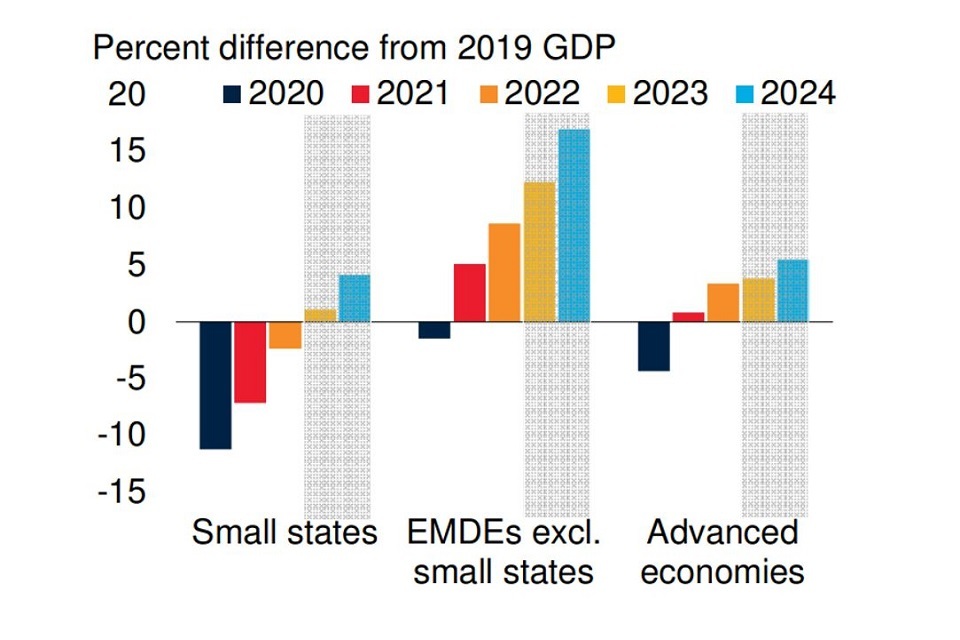
Source: WB, 2023 (PDF, 3.8 MB).
Figure 2: Small states’ debt risks have risen more than other emerging market and developing economies
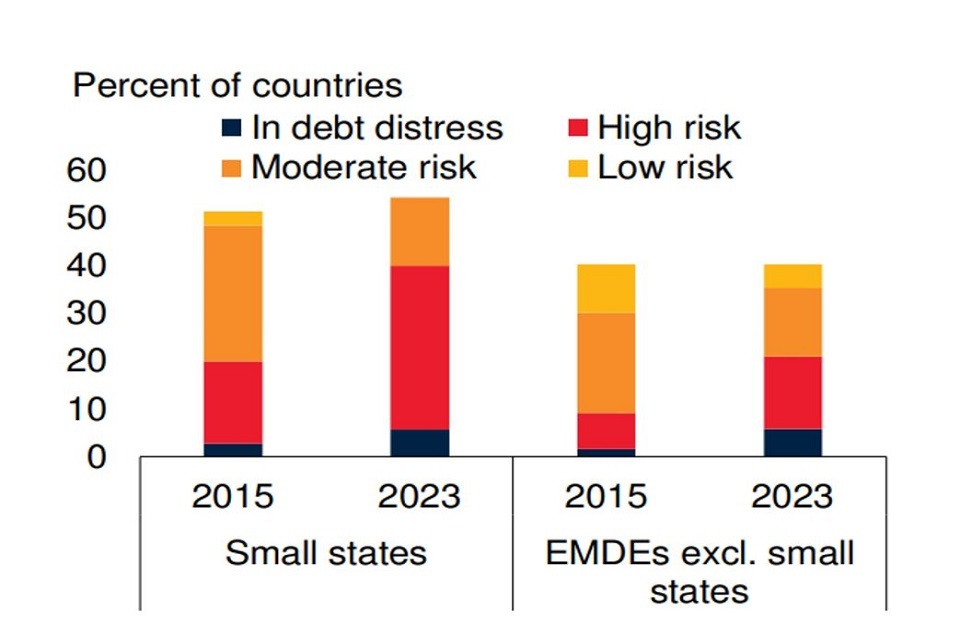
Source: WB, 2024 (PDF, 6.5 MB).
High transaction costs, trade dependence, low economic diversification, small state systems, low capacity and high debt stock make SIDS extremely vulnerable to external economic shocks, compromising growth and fiscal resilience. Small states’ output volatility is 17% higher than other EMDEs. Greater economic volatility carries adverse fiscal consequences, including more volatile and less predictable revenues and expenditures. Since 2000, annual growth of GDP per capita in small states has on average been 2.6 percentage points slower than in other emerging market and developing economies (EMDEs) and barely kept pace with advanced economies (WB, 2024 (PDF, 3.8 MB)).
The Covid-19 pandemic disproportionately affected SIDS and Small States, underscoring their vulnerability: output contracted by about 11% in WB Small States in 2020, 7 times as much as in other EMDEs and output in small states is set to continue on a lower path than expected pre-pandemic (WB, 2023 (PDF, 3.8 MB); WB, 2024). The recession was even deeper in the three-fifths of Small States classified as tourism reliant, which contracted by nearly 13% on average. Small States were due to regain their aggregate 2019 economic activity only in 2023, while other EMDEs passed this threshold in 2021 (WB, 2023 (PDF, 3.8 MB)). Tourist-dependent Commonwealth Caribbean countries contracted by on average 15.4% in 2020, compared to the EMDEs average of -1.9% (IMF REO, 2023; IMF WEO, 2024) though tourism has helped fuel recovery (IMF REO, 2024).
Volatility of global prices has an outsized impact on SIDS. Typically, food and fuel imports are equivalent to about one-sixth of GDP in Small States, substantially more than in other EMDEs. The high reliance on imports for food and fuel meant that Pacific Island Countries faced inflation in 2023 more than double that in wider developing Asia (Haver Analytics, 2024). Rising import prices pushed up inflation in 2022 despite persistently weak domestic demand. Several SIDS experienced double-digit inflation in 2022, including Mauritius, Samoa, São Tomé and Príncipe, Suriname, and Tonga (WB, 2023 (PDF, 3.8 MB)).
Climate and environmental vulnerability
SIDS face extreme climate and environmental vulnerability from their smallness, island nature, and tropical geographical locations. SIDS have rising air and sea surface temperatures, relative sea level rises, and increased frequency and severity of extreme weather. The same impact event as happens in another country can affect a greater share of their economy and society. In the most extreme cases, Sea Level Rise or a disaster event can make a whole state or a whole island uninhabitable, with limited ability to rebuild using revenues from the state’s other regions.
Figure 3: The top 10 countries/territories with the worst economic losses from single disaster events are all small islands and small coastal states, as a % of GDP (on average 2000 to 2019)
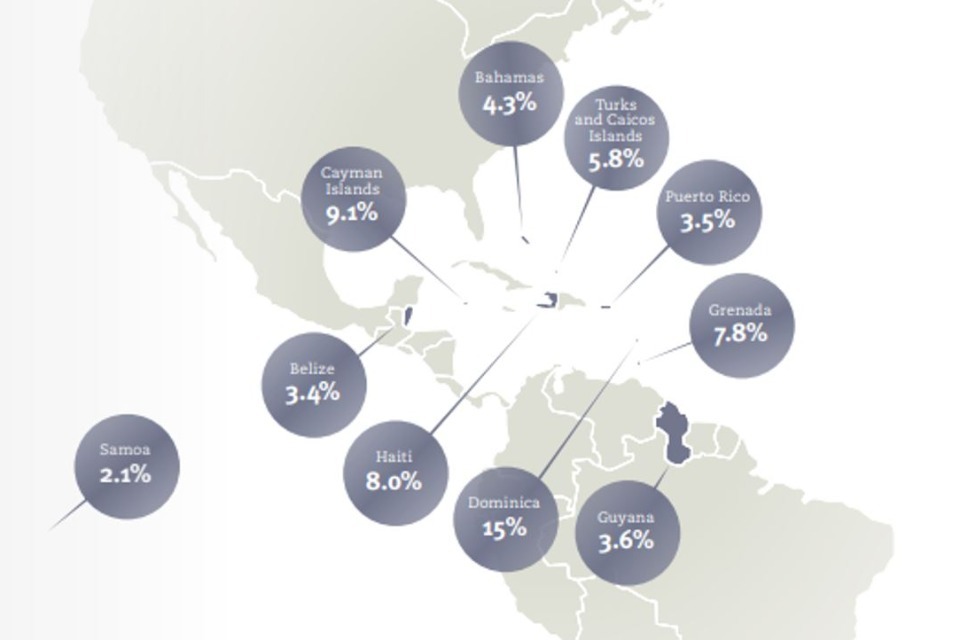
Source: UNDRR, 2020.
Data in figure 3
| Country | % |
|---|---|
| Samoa | 2.1% |
| Belize | 3.4% |
| Puerto Rico | 3.5% |
| Guyana | 3.6% |
| Bahamas | 4.3% |
| Turks and Caicos Islands | 5.8% |
| Grenada | 7.8% |
| Haiti | 8.0% |
| Cayman Islands | 9.1% |
| Dominica | 15% |
SIDS are heavily exposed to natural disasters and climate change impacts including rising sea levels, increasingly frequent and intense storms, and coastal erosion, with impacts on people’s safety, livelihoods, food and water security, and infrastructure. SIDS suffer higher levels of loss and damage from extreme weather than non-SIDS across all income groups (RESI, 2023) and SIDS have some of the highest damages from disasters, with average annual damage at 2.1% of GDP (UNCTAD, 2020) and much higher for SIDS such as those in Figure 3. Another study (IIED, 2023) indicates SIDS make up two-thirds of countries experiencing the highest relative annual losses from such events, with disaster-related damage as a percentage of GDP surging by nearly 90% from 2011 to 2022. Increasingly frequent natural disasters have contributed to rising debt vulnerabilities, disincentivised commercial investment, and pressured fiscal resources for long-term investments in climate adaptation and development.
Box 3: Case study – Hurricane Maria in Dominica
In 2017 Hurricane Maria made landfall in Dominica, resulting in estimated damages of 225% of GDP ($1.3 billion). It caused 65 fatalities in Dominica and directly affected 80% of the population. Approximately 62% of houses were heavily damaged and around 24,000 people became severely or borderline food insecure (ACAPS, 2018 (PDF, 1.1 MB)); UN, 2021. Hurricane Maria closely followed Hurricane Irma, one of the most powerful storms ever recorded that impacted 13 countries in the region in a matter of days.
For many SIDS, the climate threat through sea level rise and coastal erosion is significant, particularly for low-lying SIDS. In Kiribati, Maldives, and Tuvalu, 99% of land is below 5 metres above sea level (UNCTAD, 2021). Land area home to 10% or more of the population of many SIDS is at risk of chronic coastal flooding or permanent inundation by 2100 (IPCC, 2022 (PDF, 5.1 MB) ). Over 50,000 people in the Pacific are in danger of losing their homes each year due to extreme weather events (IDMC, 2024). In Fiji, 6 communities have been moved domestically and a further 40 are waiting to be relocated because of the impacts of climate change.
Governance and capacity vulnerabilities
SIDS face an acute vulnerability of limited capacity, which constrains both public and private sector delivery. Small populations limit the availability of expertise and often translate into relatively low numbers of qualified staff working in key capacities (OECD, 2018).
Human and institutional capital is difficult to build and maintain in small states due to small populations and often high outward migration. Many SIDS face significant outward migration, driven by vulnerabilities including climate, socio-economic fragility, and limited job markets (UNDESA, 2024 (PDF, 560 KB)). Despite remittance benefits of migration, many SIDS are concerned by labour shortages and migration of skilled professionals creating a “brain drain” (UNDESA, 2024 (PDF, 560 KB)).
Small states often face acute governance challenges with limited state capacity, volatile revenues, and high government costs relative to the small size of the economy due to the high fixed costs of public administration and provision of public services and infrastructure. Both annual government spend and tax revenues as a share of average GDP are about 8% higher among World Bank Small States than other emerging and developing economies, but small states are more reliant on non-tax revenues (WB, 2023 (PDF, 3.8 MB)). Small states’ revenues are more volatile than other EMDEs due to vulnerability to external shocks (WB, 2024). SIDS and small states can increase tax efforts and strengthen domestic resource mobilisation; Figure 4 shows that at the point of ODA graduation, SIDS’ tax revenues are double their external finance inflows compared to 9 times for non-SIDS (OECD, 2024; OECD, forthcoming; WB, 2024). Strong fiscal policy is particularly critical in SIDS given debt challenges and the outsized role fiscal policy plays in macroeconomic stabilization and promoting external balance, given the absence in most cases of exchange rate flexibility (WB, 2024).
Compared to larger states, small state governments tend to have limited capacity to undertake activities, higher personalism, reliance on informal relations, and low costs of state capture (Institute of International Affairs, 2020). Important public administration activities requiring significant state capacity include enforcement and engaging with international financing systems. Capacity of media and civil society is also often limited by scale. The combination of these factors can both increase risks of corruption and illicit finance and limit small states’ capacity to manage these governance threats.
Social vulnerability
SIDS have particular social vulnerabilities. Women are disproportionately vulnerable to climate change and in the aftermath of climate disasters, for example cyclones are associated with increases in gender-based violence (GBV). Compared to men, women have lower labour force participation, and less formal, worse paid roles (Work and Opportunities for Women, 2023 (PDF, 2 MB)). Most SIDS criminalise consensual same-sex sexual conduct and none allow other rights for same-sex marriage or adoption (K4D, 2021).
Box 4: Gender-based violence (GBV)
The Pacific has some of the highest rates of GBV globally, with 68% of Pacific women reporting intimate partner violence in their lifetime, which is double the global average (UNDRR, 2022). Disasters have been reported to increase GBV, including a 300% increase in new domestic violence cases in a Southern province of Vanuatu after 2 tropical cyclones hit in 2011 (UN Women, 2012 (PDF, 2.1 MB)).
The Caribbean also suffers high GBV: roughly 45% of Caribbean women experience intimate partner violence during their lifetimes (UNICEF, 2023 (PDF, 715 KB)), and Caribbean countries have 4 of world’s 10 worst femicide rates, with Jamaica ranked second (World Population Review, 2024).
Climate change in SIDS is directly harming human health in SIDS (Gordon-Strachan et al, 2024). This includes through burden on healthcare systems, spread of infectious diseases, mental health and wellbeing, displacement, heat stress, access to healthy food and safe water, and increasing non-communicable diseases Indirect impacts include through agricultural and marine resources linked to food security and broader economic opportunities. With small populations already limiting human capital, health deteriorations further dampen labour productivity. Evidence on SIDS human development relative to other countries remains mixed, with slow long-term progress (OECD, 2018).
Climate change affects culture and social structures in SIDS. Climate-related migration is expected to increase and become increasingly important to SIDS (IPCC, 2022 (PDF, 376 KB)). In a country of just one or several small islands, people cannot stay within their state if land becomes uninhabitable (either permanently or temporarily). Many SIDS populations have strong cultural ties to their specific land.
Financial vulnerabilities
SIDS’ vulnerabilities, particularly size and some SIDS’ debt unsustainability, limit their ability to attract commercial finance, driving up costs of financing. With higher transaction costs and disaster risk, both business and development operations tend to be more expensive per capita and more difficult to deliver effectively. This makes thresholds for self-financing higher and even unachievable for some SIDS.
Vulnerabilities combined with limited access to commercial finance make development partnerships and concessional finance even more vital to SIDS. SIDS are more ODA dependent than non-SIDS – both a symptom and a source of vulnerability for SIDS. At the point of ODA graduation, ODA made up 38% of external finance flows for SIDS versus 2% for other graduating countries, though less than Low Income Countries (LICs) (on average from 2017 to 2022, OECD, 2024; see figure below)[footnote 1]. Pacific SIDS are more reliant on ODA than the Caribbean: ODA per capita for Pacific SIDS in 2021 was $639 compared to $217 in Caribbean SIDS and just $75 dollars in LICs (Haver Analytics, 2024). The cost of delivering aid in SIDS tends to be higher than in other countries due to SIDS’ remoteness and small size, 4.7 times more according to IFAD (2014) though more recent estimates are needed. High costs and difficult operating environments can lead to lower programme success (Feeny & Vuong, 2017; ADB, 2021). Nonetheless, ODA to SIDS has been small in absolute terms, at 1.55% in 2017 to 2021 (UN, 2024 (PDF, 196 KB)). Debt risks in SIDS would be even higher if not for strong concessionality of development financing, particularly in the Pacific.
SIDS struggle with accessing and absorbing finance due to capacity constraints and their vulnerability not being reflected in finance eligibility criteria. The Glasgow Climate Pact agreed at COP26 encourages finance providers to consider how vulnerability can be reflected in the provision and mobilisation of concessional finance. Most International Finance Institutions account for SIDS’ vulnerability, but the critical DAC ODA eligibility criterion is based only on income without vulnerability.
Priorities to make the shift from vulnerability to resilience
Supporting SIDS in the shift from vulnerability to resilience includes the following though not limited to this.
- improving quality of finance: implementing the SIDS Development Effectiveness Principles with strong development coordination and smoothing the path away from concessional finance, including improving the ODA Graduation process. Development operations must be tailored to small state systems
- mobilising more finance: needs exceed public funds alone. While the $300 billion climate finance goal agreed at COP29 will help poorer countries obtain finance, public resources need to catalyse far greater private finance and providers need to enhance access to climate finance for the most vulnerable, including SIDS
- governance improvements: strengthening fiscal resilience with domestic revenue mobilisation and fiscal buffers, while enhancing capacity. (See Chapter 4 ‘Fiscal Challenges in Small States’ in WB, 2024 (PDF, 6.5 MB))
- regional integration: increasing scale for governance and operations
- shock responsive finance: making the international finance system more shock responsive by scaling up disaster risk innovations. This includes the continued roll-out of climate resilient debt clauses (CRDCs), aimed to decouple the climate and debt risks by temporarily pausing debt repayments in the wake of a disaster, boosting fiscal space for crisis response in a cost-neutral way
- disaster risk reduction: investing in disaster risk reduction. Every US$1 invested in risk reduction and prevention can save up to US$15 in post-disaster recovery, and every US$1 invested in making infrastructure disaster-resilient saves US$4 in reconstruction. Despite this, only 50% of disaster-related ODA goes to prevention (UNDRR, 2024)
- prioritising sectors for growth: deepening economic resilience through economic diversification and enhancing economic productivity. This is likely to include: blue economy; renewable energy which would help protect SIDS from global price shock; utilising technologies to overcome barriers of scale and remoteness; financial sector deepening including tackling debanking
Figure 4: SIDS are much more reliant on ODA than other countries at the point of graduation ($13,845), while struggling to mobilise private finance or domestic tax revenues
Non SIDS
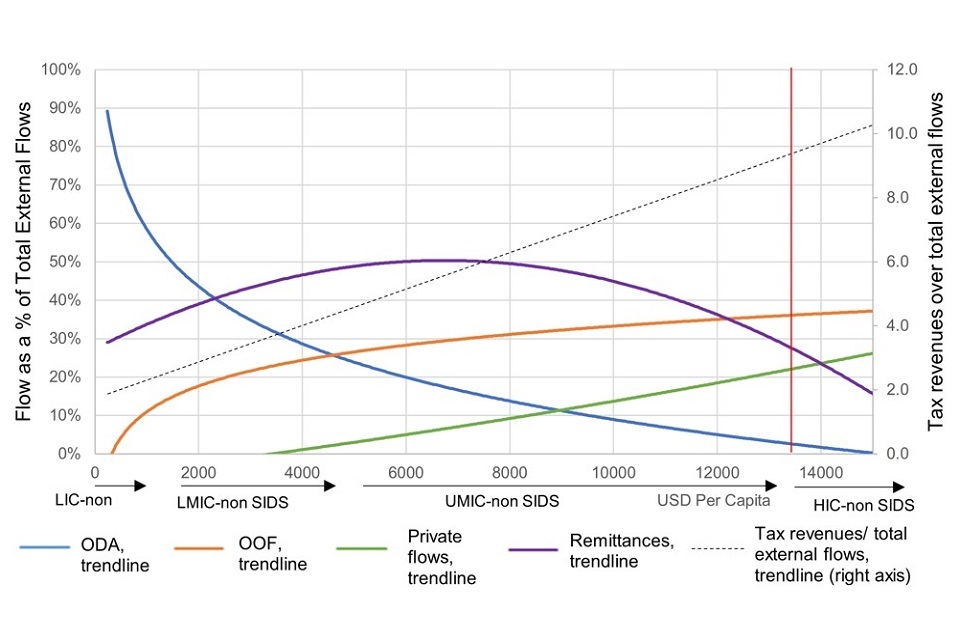
SIDS
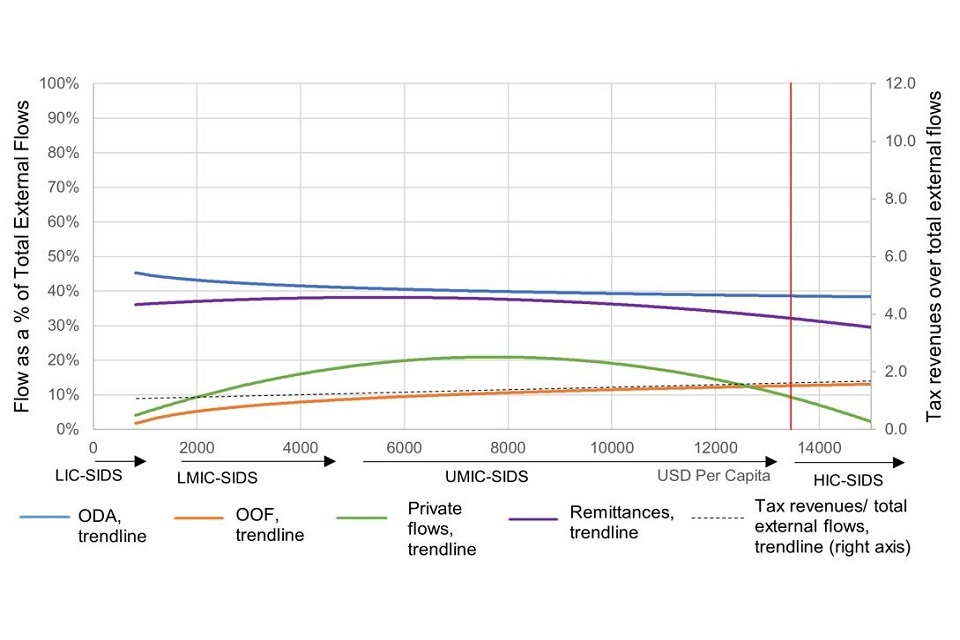
Source: OECD, 2024, 2021 prices using OECD definition of SIDS. OOF = Other Official Flows
-
SIDS closest to graduation are all microstates, but OECD (2020 (PDF, 661 KB)) analysis on non-microstates showed an average of 27%. ↩
